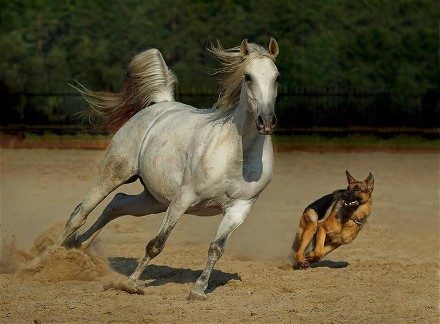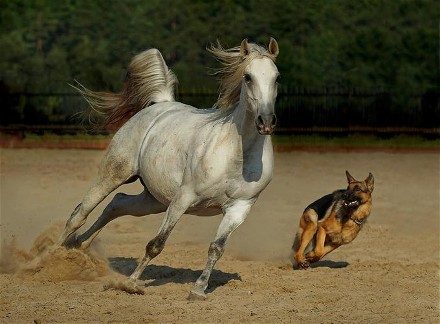

Dog and Pony Act
Dogs and horses fascinate me. Both pack (or herd) animals, both full of bluster and libido, both wedded to a hierarchical style of group think. Bombastic, loyal, athletic, with real personalities, likes and dislikes. And, both have nearly immeasurable histories with us, which helped to shape and define our own culture. Really, where would we be without them?
But there are fundamental differences. Horses are herbivorous prey animals, while dogs are carnivorous predators. Horses traditionally led a nomadic life, dictated by availability of graze, while canids preferred to establish and defend a more specific hunting territory, Horses are now huge, dogs relatively small. And horses live 25-30 years, while our beloved pooches rarely stick around for more than 15. Too bad we can’t splice in a little miniature horse DNA into them.
Humans have been training both species for years; we make use of their superior abilities, and in return they get food, shelter, attention, and purpose. Pretty good trade, I’d say. Dogs, though, have of late taken an odd turn from this quid pro quo; most of them no longer have to perform tasks in exchange for sustenance and attention. In an almost feline sense, all they need do now is serve as companions, in order to fulfill their end of the deal. Most of you know how I feel about that- I think that in order to be truly happy and confident, dogs need active purpose- but that’s not what I want to talk about today. Well maybe. We’ll see.
I just began working with a 6 year old Jack Russell/Chihuahua mix named Chip. He’s a nice dog with a sassy, independent streak, and a penchant for antisocial behavior with other animals. He spends his days with his owner at a fabulous dressage facility in Western Washington, where at any given time there might be over a dozen beautiful horses of varying size and breed, some in the stable, and others out in their corrals.
As soon as Chip is let off his leash, he storms off into the corrals and begins to harass the horses, chasing, barking and nipping at them, as if to say hey you big dummies, this is my field, get out of my face. "Tenacious C" might be a good rap name for him.
Horses are spirited, thousand-pound animals. At some point, one of them will probably kick a field goal with Chip. So, I’ll work on the situation, for Chip’s sake, and for the peace of mind of everyone. It’ll be fun, actually, and I’m looking forward to it. I’ll keep you informed on his progress.
I’m a good dog trainer, but I know next to bupkis about horses, except that they are big, strong, fast, and a bit flightier than dogs, perhaps due to their heritage- that of a prey animal. Along with the bison, deer, elk and the antelope, they once roamed the plains and woodlands of North America, grazing, mating, contending with each other, and avoiding predators like the dire wolf, the saber-toothed cat, early human hunters, and others.
In truth, though similar in their penchants for maintaining social hierarchies, and for communicating through body posture and a variety of vocalizations, horses and dogs really occupy different sides of nature’s fence, in that one often got eaten by the other.
Chip isn’t going to eat a thoroughbred anytime soon. But he might get kicked into next Thursday by a "prey animal" fifty times his size. So, I’ll work on boundary training, basic obedience, desensitization, long-range recalls, and a host of other behaviors with him, in concert with removing unfettered access to the equines. And I will try to find Chip a new muse, to replace the one he’s created- namely chasing giants as if they were squirrels. Ah- there’s my "lack of purpose" mantra again. It’ll be a long term project, and I’m excited over it, not so much over fixing Chip, but by learning a thing or two from the horse trainers.
A horse trainer is faced with an interesting challenge, namely convincing a thousand pound animal who can run forty miles-per-hour and jump an eight-foot fence, to perform, behave, learn, and obey. Certain techniques that might work with a dog simply won’t succeed with a horse; you can’t pick a horse up, can’t outmuscle it, can’t physically pull two horses apart, and so on. Instead, you need to use your head, and your knowledge of the animal to train, and modify. Good horse trainers know how to use their bodies to not only control a horse’s position and movement, but to also slowly establish ownership over space- a natural mimicking of what horses do with each other in the wild. When you control an area, you instantly create a rank, and a semblance of governance; it’s subtle, but it’s a key to establishing control over an animal eight times one’s size.
I do the same thing with dogs. No matter their size, age, breed or personality, I always use the positioning of my body as a communicative tool. Dogs understand posture and position so completely, so quickly; it must be part of every good trainer’s methodology. For instance, when I took Chip into the corral with Gino, a curious, confident horse who Chip had earlier chased, I initially placed my body in between the edgy dog and the horse, disallowing any greeting or snarling, and simply initiating a directed, purposeful walk around the space. On an extendable lead, I gave Chip a bit of freedom when he behaved, then reeled him in a bit when he started getting bossy or anxious. Curious about what I was up to, Gino followed us about, even giving me a nibble or two on my coat sleeve. The simple goal was to get Chip to cohabit the corral with Gino without him firing up. I used "positional power" to do that. And, at the right moments, a few tasty treats.
Ironically, horse trainers will sometimes run from a horse in order to catch it. Clearly too fast for a human to capture, a horse will often respond to this trick, and out of curiosity trot over to see what the crazy person is doing. It’s similar to what alpha horses do; a stallion will rarely follow, but instead choreographs his own agenda, knowing that the subordinate horses in his herd will follow his lead. A simple way to use herd psychology to one’s advantage.
I often use the same technique to teach the recall command to stubborn dogs. Once I establish a decent relationship, and have worked a dog on leash, I’ll often go to a fenced-in area, then walk or run away from the pooch. Whether it’s due to the dog wanting my company, or to its natural, predatory urge to chase a moving object, the technique almost always works better than trying to catch the dog- usually an exercise in futility, and a good way to teach the dog that you are slower, and merely "puppy-like" in importance.
Though dogs are more "fight" and horses more "flight," both will often react fearfully to situations they deem potentially harmful, or scary. It’s why both dog and horse trainers try to use as much positive reinforcement as possible, and minimize negative experiences. In the case of a scared horse, it’s crucial to reduce the chances of a panic, as it can result in a stomping, a painful head butt, or a crow-hopping buck-fest across a corral that ends with a rider face-planted into the mud. With a panicked dog, it can result in a bite incident, or with the pet running into the street and getting flattened by a truck. In either case, good trainers know how to minimize panic, maintain control, and inject an air of confidence into the process.
I know I’ll learn a lot in the coming weeks, as I work Chip at the dressage facility. Maybe I’ll get him a tiny saddle and perch a teacup poodle onto his back… or maybe not. But, in teaching him to respect the horses, I know I’ll come to respect the skills of horse trainers and riders to teach their sinewy, thousand pound giants to behave, and excel. If I’m lucky, maybe little Chip will, too.
Join the newsletter and never miss out on dog content again!
"*" indicates required fields
By clicking the arrow, you agree to our web Terms of Use and Privacy & Cookie Policy. Easy unsubscribe links are provided in every email.